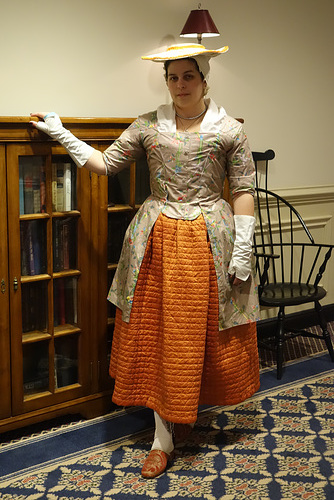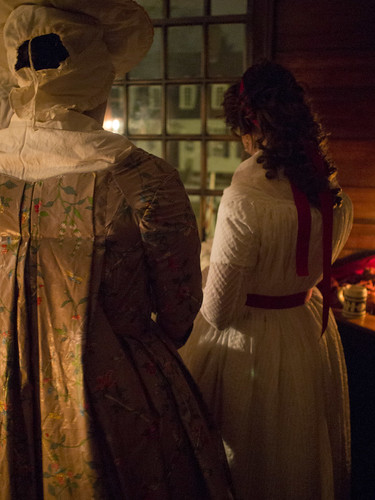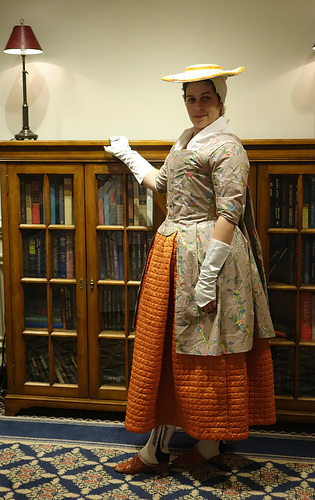Welcome to the world of Medieval Chicken Nuggets known as chewets. Cause they are chewy. And good. Really good. I think I like them more than modern chicken nuggets....
The Challenge: 18. Descriptive Food January 25 - February 7
We all know those recipes that come attached to interesting and imaginative names - slumps, crumbles, buckles, trifles, flummery. Pick a historic recipe that has a descriptive title
The Recipe: (where did you find it, link to it if possible)
Chewets. Recipe þe draghtis of capons or of hennes & shop þam small. Take & cast powdyr of gynger & cloes, pepyr & salt, & put þam all in a lityll cofyn & close it abowne, & fry hym in fresh grece, & serrof þam forth .ij. in a dysch.
Chewets. Gather capon or hen leftovers and chop them small. Take and cast powdered ginger and cloves, pepper and salt, and put them all in a little coffin and close around, and fry it in fresh grease, and serve them forth 2 in a dish.
I got the above from
MS Harley 5401 which is a 15th C English cookbook.
The Date/Year and Region: 15th Century, England
How Did You Make It: (a brief synopsis of the process of creation) I cheated. I'm going to fess up right now. I used a store bought, dairy aisle, pie crust rather than making my own. I also used the thin chicken breast pieces you get at the store to cut up and make modern chicken nuggets.
I first turned on the oven to 375f and the cooked three of the thin chicken breasts for five minutes, flipped 'em over, and cooked 'em for another five. Once they were done, I cut the chicken up into small, bite sized pieces.
On the counter, I sliced up the pie crust into small rectangularish pieces to wrap the chicken pieces in. I put salt on the pastry pieces first, followed by regular old black pepper. I only put a small amount of ground cloves on each piece and about the same amount of ginger on each piece as I did with the pepper. The salt was the most heavy but I really sprinkled each on so I have no idea the exact amounts.
I then wrapped up each piece of chicken in the pastry crust and fried them in some olive oil in a frying pan.
Time to Complete: One hour but that was only because I ended up using both pastry crusts and 2 1/2 chicken breasts - it ended up being enough nuggets for...umm...a while.
Total Cost: I only used half of the chicken package for $3.50 for that and another $3.50, I think, for the pie crust. Everything else, I had on hand.
How Successful Was It?: (How did it taste? How did it look? Did it turn out like you thought it would?) Seriously, it's delicious. I ate them like I eat modern chicken nuggets - with honey. I think I might make this one for my nephews. They look like chicken pockets which is pretty much what I figured they'd look like. I was a bit concerned about the taste because of the cloves and ginger but it ended up being a great combo with the honey for a dip.
How Accurate Is It?: (fess up to your modifications and make-dos here) Like I said, I cheated on the crust. However, the chicken was...chicken. The olive oil was olive oil... I used my modern oven and modern pots and pans.
Additional stuffs:
I think this is my favorite recipe I've tried yet. It's really just medieval chicken nuggets. I think these might be a good appetizer at a party or another gateway food into the world of medieval cooking.
I choose this recipe because of the name - chewets. They are small chewable bits. :-) There are a couple of different recipes for them but I liked this one because it was so simple. Chicken, pie crust, pepper, salt, ginger, and cloves. Fry it up in some oil.
The original recipe mentions using leftovers - we all still have that bit left after destroying a rotisserie chicken from the grocery store. You don't want to throw the chicken away because there is kinda sorta enough chicken for maybe one person - well, this is what you do with that chicken! You make it into another meal.
I probably made them a bit big - I think they are supposed the be about the size of a coin (another recipe mentions a penny) but they were chewable and they were delicious.























